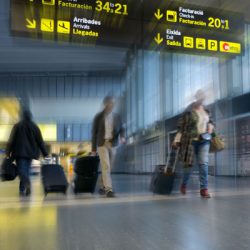Mumbai Airport’s Terminal 1-B opens Oasis Lounge
The new lounge can host 45 patrons at one given point, but is capable of accommodating 200 travellers during peak hours.
List view / Grid view


‘Seamless travel’ is a term frequently being used to describe the optimum passenger experience, meaning a traveller can complete the entire airport journey without experiencing delays, disruption or confusion.
Self-service technology, predictive analysis, artificial intelligence, real-time information and data-sharing are just some of the digital concepts airports around the world are deploying in an attempt to achieve a seamless passenger experience.
International Airport Review, within this core topic, endeavours to provide case studies on how airports from all corners of the world are working on improving their passengers’ experience. This covers both inside the terminal, and initiatives implemented outside of the terminal that focus on ensuring the passengers’ arrival to the airport is as easy as possible.
This is a key theme in the airport industry that must not be overlooked: As passenger expectations evolve, an airport’s response must do so too.
The new lounge can host 45 patrons at one given point, but is capable of accommodating 200 travellers during peak hours.
It is the aim of an airport to ease the journey and ensure it is a positive experience for all passengers, including those with reduced mobility or additional needs. Although the intention is the same, how airports are approaching this varies.
Alexandre de Juniac, Director General and CEO of IATA, discusses how improvement and investment in two integral areas of the aviation sector is essential if the industry is to remain successful in the future.
The proposed expansion at Heathrow will see the M25 diverted and redirected through a tunnel to make way for the development of the third runway at the airport.
Income per passenger has grown by 4.5 per cent in the last year as Gatwick serves 46.4 million passengers, including an extra 1.1 million long-haul passengers.
In this issue, find out about how artificial intelligence can manage even the worst of cyber-security breaches; how to ensure increasing drone traffic in Europe’s skies can be managed safely, and various approaches to enhancing non-aeronautical revenues.
Passengers can benefit from even more independence and flexibility at departure with Hamburg Airport’s self bag drop. Michael Eggenschwiler, Chief Executive Officer, Hamburg Airport explains how the experience of the technology to date leaves no doubt that automated baggage check-in is the right solution for the future.
Anders Nielson and Lone Teist detail how Billund Airport – regional in size but one that bears the complexity of a large-scale airport – has had to embrace self-service technology and automation within baggage handling to increase its capacity.
Recent information screen blackouts at Gatwick and Heathrow have highlighted that airports need to diversify their information delivery systems.
Cameras that track vehicles touting and tailgating, which has recently increased at drop-off points around the airport, have been installed.
The Master Plan includes an investment of £500 million which will focus on transforming the terminals and therefore the passenger experience.
As airports handle record numbers, crowded check-in halls are becoming more commonplace, prompting airports to rethink their approach to space, resources and passenger experience.
In an exclusive from David Gammie, CIO at Edinburgh Airport, we hear how smart networks help to meet increasing passenger demands for connectivity while delivering 24/7 business critical operations.
In May alone Heathrow witnessed nearly seven million passengers pass through its doors, the 31st consecutive month of growth. But can this continue?
In collaboration with Delft University of Technology, Schiphol will act as a 'living lab' for the next five years as the partnership aims to develop innovation throughout the airport.